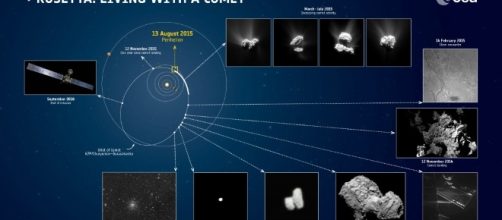The Rosetta mission is planned to conclude soon. The increased distance from the sun prevents the spacecraft from obtaining energy to operate its instruments. This has caused a reduction in bandwidth, reducing its capability to retrieve scientific data. Moreover, the spacecraft will soon be behind the sun due to conjunction. Scientists have decided to end the mission next September 30.
Rosetta
This is a mission by the European Space Agency (ESA) launched on March 2, 2004. Philae, its lander module, was launched on the same date. On August 6, 2014, the spacecraft reached comet 67P/Churyumov-Gerasimenko and was placed on an orbit around comet.
On 12 November of the same year, Philae lander was released onto the comet´s surface.Rosetta remained close the comet´s nucleus, while the comet followed a path that took it closest to the sun. The main goals of this mission included, studying the processes occurring while the comet approaches the warmer temperatures of the sun; mapping and finding out the comets components, for this task, the spacecraft dispatched a controlled lander (Philae) over the comet.
Far distance from the sun
At this time, Rosetta is travelling along with comet 67P in direction to the outer solar system and have reached a distance of more than 830 million km (515.7 miles), making it the farthest distance that Rosetta has ever gone before.
This has diminished the vehicles ability to store solar power to maintain its heaters on. Scientists have decided to release the spacecraft unto the comet´s surface.
Rosetta´s destiny
Instead of making the spacecraft hibernate, as it has been done before, scientists have decided to plummet the vehicle over 67P. On the date of the plunge, Rosetta will be able to obtain high resolution images of the comet, like never before. Once Rosetta reaches 67P´s surface, radio communications will dim and the mission will be concluded.
67P/Churyumov-Gerasimenko
This is a Kuiper belt icy comet with an orbital period of 6, 45 years. It measures approximately 4 km across (2.5 miles) and has a mass of 10 billion tons.
Although, the comet seemed like a piece of rock, it was made of lighter material that would float on water. Philae lander measurements revealed 16 organic compounds. Molecular oxygen was found surrounding the comet.
Important discovery
Rosetta discovered the amino acid glycine, which is made of a chain of carbon, hydrogen and oxygen. Some asteroids and comets are known to contain water in them, with a similar composition of earth´s oceans; however, in previous discoveries, Rosetta found significant discrepancies in this comet that arouse the debate on their role for the origin of life on earth.
The new results revealed what had been suspected before about the likelihood of comets to have delivered the ingredients for the development of life.
The Rosetta mission and its discoveries opens new posibilities for cosmology, searching for more answers to the origins of life in the universe. Scientists are studying other astronomical bodies using varied vehicles with the intention to understand the origins of life in the solar system.

